2022/23, Erling Haaland signs for Manchester City. He’s not the typical Guardiola forward, and he’s a far cry from the false 9 City were using the previous season. While the lack of a clinical striker led to games with endless chances and no solution, it also created a sense of fluidity, with the ‘false 9’ stringing the extra passes to exert control.
With the centre-forward position now being taken up by a ruthless finisher, but a less technical player, Pep Guardiola has had to adapt and find ways to provide his generational striker service while maintaining control and technical security.
Earlier, City started their first-phase build-up in a 4-3-3, which eventually transitioned into a 2-3-5, with Cancelo and Walker inverting alongside Rodri.

While it increased the supply to Haaland (with De Bruyne and Gundogan in the half-spaces), it also left City transitionally stranded, as the cracks started to open wide. It led to situations where City were conceding goals through counters, where the 2-3 build-up would often get outnumbered by opposition attacks. Lower-table teams, blessed with money and individual quality, now had the transitional threats to pounce on City’s tactical errors and open spaces- Ivan Toney, Saint-Maximin- give them a bit of open space, and they will slice through your defence with a simple pass, a burst of pace, deceiving movement.
It’s how Manchester United scored their winner vs City at Old Trafford. Akanji commits forward, which leaves Ake and Cancelo back to defend.
City have two men at the back, which doesn’t match up well with United’s front three.
This leaves Garnacho free, who produces the assist to Rashford for the winner.
More recently, when City tried maintaining a 3-2 build-up, ditching this structure has led to unfavourable circumstances.
Against Liverpool at the Etihad, Ake jumps forward to defend with Rodri and Stones. This creates a good 3v2 battle for Liverpool and leaves Akanji to deal with 2 men. While he doesn’t completely cover himself in glory, losing his physical duel to Jota, the 2-3 structure clearly has issues when dealing with counterattacks and transitions.
https://twitter.com/OFuraRedes/status/1642132306465808384?s=20
By December, City were experiencing games where they weren’t able to create sufficient chances, nor were they able to stop conceding goals. The 2-3 shape, and Cancelo’s tendencies to roam forward, left Rodri stranded in the second phase.
Post World-Cup, Pep put a stop to that, realizing that he had to find a way to maintain control, and still use the verticality and risk to find Haaland.
Enter the 3-2 structure.
City have used this in the past. A common feature of City’s previous set-ups was that Walker, the right-back on paper, would drop back as the team’s 3rd centre-back, while Bernardo Silva formed a double pivot with Rodri. The inclusion of Walker was a cheat code for City, as his recovery pace meant City could deal with attacks much easier.
The key difference was that City often started out in the 4-3-3 shape, as mentioned above. This season, however, has seen a change in that sense. Rather than starting out in a 4-3-3, City have directly jumped into a 3-2 shape, with one of the fullbacks practically behaving as a midfielder. Rather than inverted fullbacks, they are ‘everted’ midfielders, players that ‘stick’ to their position in midfield.
https://twitter.com/Jon_Mackenzie/status/1624910679844028416?s=20
An inverted fullback normally starts out as a wide fullback in a back 4. In the second phase of play, the fullback drifts into midfield, offering help in circulating the ball in the first and second phases.
Post-World Cup, however, the fullback (in this case, Rico Lewis or John Stones), does not behave like this. Instead, they act as midfielders, sticking to their double pivot from the very first phase.
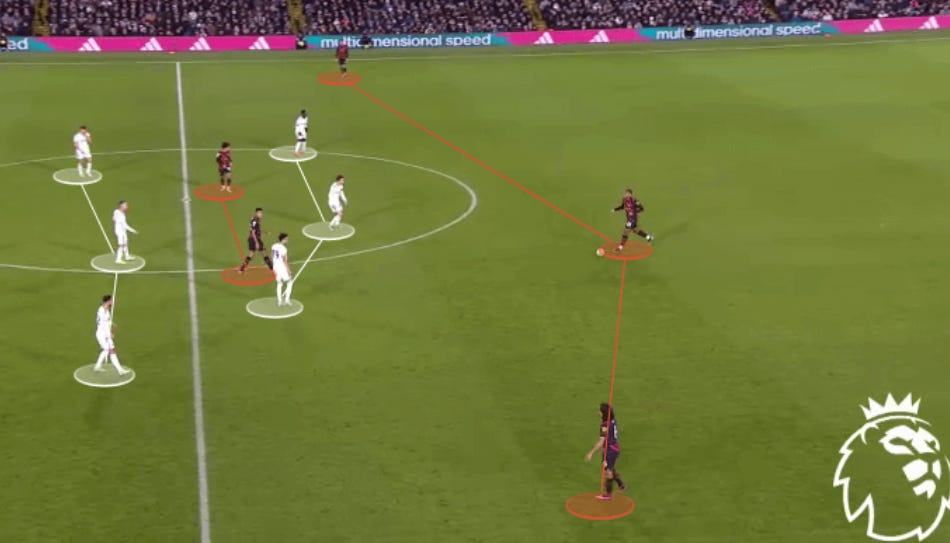
The off-ball dynamics remain the same. It’s a standard 4-4-2/4-3-3, with the 2 forwards pressing the centre-backs, the wingers pressing the opposition full-backs.
This 3-2-5 has further blossomed into a 3-2-2-3, a concept that is known as the ‘box midfield’. This four-man midfield forms the basis of Pep’s tactical tweak and has brought incredible change to City, in terms of build-up, numerical superiority, and defensive stability.

What does the box do?
The box midfield, comprising four narrow midfielders, is all about creating superiority. Its most important function is overloading the central areas with midfielders. Typically, other teams use a 3-man midfield, and matching up with this box midfield results in a free man being left, which leads to a beneficial spell of possession.

A box midfield always allows teams to create a free man in possession, ensuring there are numerical superiorities everywhere. There are more opportunities for passing triangles, one-touch passing, etc.
If a team sets up in a 4-3-3, there is an easy 7v6 advantage for box teams, with the back three and midfield outnumbering the opposition’s attack and midfield. It’s all about taking advantage of space, from there on.
If space is present on the left, the winger can drop deep to pick up the ball. If the fullback tracks him, this leaves gaps in the half-space/wide areas- spaces that can be vacated by the left-sided midfielder.
City have used this multiple times on the right- a trademark move is Mahrez/Foden moving inside, allowing De Bruyne to overlap/underlap- it’s hard to mark him, there’s plenty of space which means he can produce a cross to create a goal.
It also leaves a spare man in build-up if need be, helping City carry the ball in the first and second phases.
More importantly, this box midfield can also help create space for the wingers.
City’s equalizer against Liverpool at home represents this very concept. Henderson marks De Bruyne. Robertson steps out to press De Bruyne. While 2 men are on the Belgian, it leaves Mahrez free. De Bruyne slips in a clever pass to him, and Mahrez has free space and good angles to dribble through, and it leads to Alvarez’s tap-in.
The profiles of the defenders
In the past, City’s best defence comprised two CBs- one aggressive and front-footed, the other less reactive. There were two fullbacks too- one was given the license to roam, and the other stayed as a third centre-back.
Joao Cancelo, gifted as he is, misjudges crosses and has shown the failure to track back properly, as seen at the Bernabeu last season. Kyle Walker, for all his speed, can display a lack of positional awareness, occasionally showing lapses in concentration.
This time around, it’s been four centre-backs. While the idea sounds haunting, given that it could mean a loss of chance creation, it’s the profiling, talent ID and excellent use of strengths that makes it work so well.
Nathan Ake, excellent in wide areas and in aerial duels, fits this hybrid role perfectly. In possession he’s tidy, willing to push up, but out of possession he works hard, and poses a significant threat against tricky wingers.
Ruben Dias, a phenomenal pure defender, specialises in the box, using the right amount of aggression and positional sense.
Manuel Akanji is a player I’ve been quite critical of recently. Possessing a good amount of pace and technical ability on the ball, I think his fundamentals can be quite poor- failure to misjudge long balls and crosses, physically poor in duels. However, his importance in the build-up, as well as certain big-game performances, mean he’s been heavily relied upon by Guardiola.
John Stones, the embodiment of completeness
I would need a lot more than a paragraph to describe how immense John Stones has been.
Typically, Guardiola has used Rico Lewis and Bernardo Silva in this double pivot role, with the former doing exceptionally for a player his age. However, their off-ball defending isn’t quite world-class, but that also isn’t their fault.
John Stones takes his qualities as a CB and combines them with his on-ball skillset to play alongside Rodri- a role he has been terrific in. High-line defending, awareness in the box, aerial dominance- tools that his previous fullbacks have shown a lack of, John Stones has displayed his talents in the defensive art.
His ability in possession is special. He receives the ball on the half-turn with elegance and is blessed with intelligence in short passing and positional discipline. He’s also excellent in spraying the ball and switching play.
How often do you come across a centre-back who can play as a wide centre-back, and a second midfielder in a pivot? This unicorn-like profile, gives Guardiola the quality he needs in the first and second phases, whilst also maintaining enough physicality and brute force to maintain stability at the back. It’sunique.
Technical Wingers
Pace, dribbling, off-ball runs, clinical, creative- these were qualities possessed by Sterling and Sane, two players pivotal to the success of ‘Centurions’ in 2017/18. Since then, Guardiola’s idea of a wide forward has seen drastic changes, including using no.10s like Bernardo Silva and Phil Foden as wingers.
Pep’s vision has finally become clear, using Jack Grealish and Riyad Mahrez. Neither of these players are the quick, off-ball threats the 17-18 duo were, but they’re slow, methodical, and technical- qualities that Pep appreciates. While they are not outlets, they minimise transitions from the opposition- players that take the time to string extra passes, and players that keep the ball in threatening areas, ensuring there is less of a chance of creating a turnover.
Press-resistant wingers are much more useful than people think. They don’t just help keep the ball, their movements help drag markers along with them, creating space for others to run into. These are the elements fans won’t be willing to pay attention to but are details that often contribute to the success of the team.
It also helps that Grealish and Mahrez now play with much more intent, willing to take on players, and making more runs into the box. This drive, combined with the press resistance and willingness to spend more time in the final third, is what makes City’s overall play much more devastating.
A more recent introduction into the set-up is baiting the press, wherein the centre-backs/goalkeeper use their body orientation to trick the defenders, drawing in the press and using quick, vertical passes to create ‘artificial transitions’. It’s a principle that reminds one of Robert De Zerbi, Brighton’s manager.
https://twitter.com/_TheNearPost/status/1645002955177746432?s=20
Premier League Champions?
Pep Guardiola's new box midfield system is fantastic, and it is possibly his most complete setup in terms of generating and defending in all phases. He not only has Erling Haaland and Kevin De Bruyne in attack but also has more physical and fundamentally strong defenders in Nathan Ake and John Stones to defend the wider areas.
Can City reclaim the title, and even defeat their Champions League demons? Only time will tell, but this is another step in the evolution of Manchester City under Guardiola.







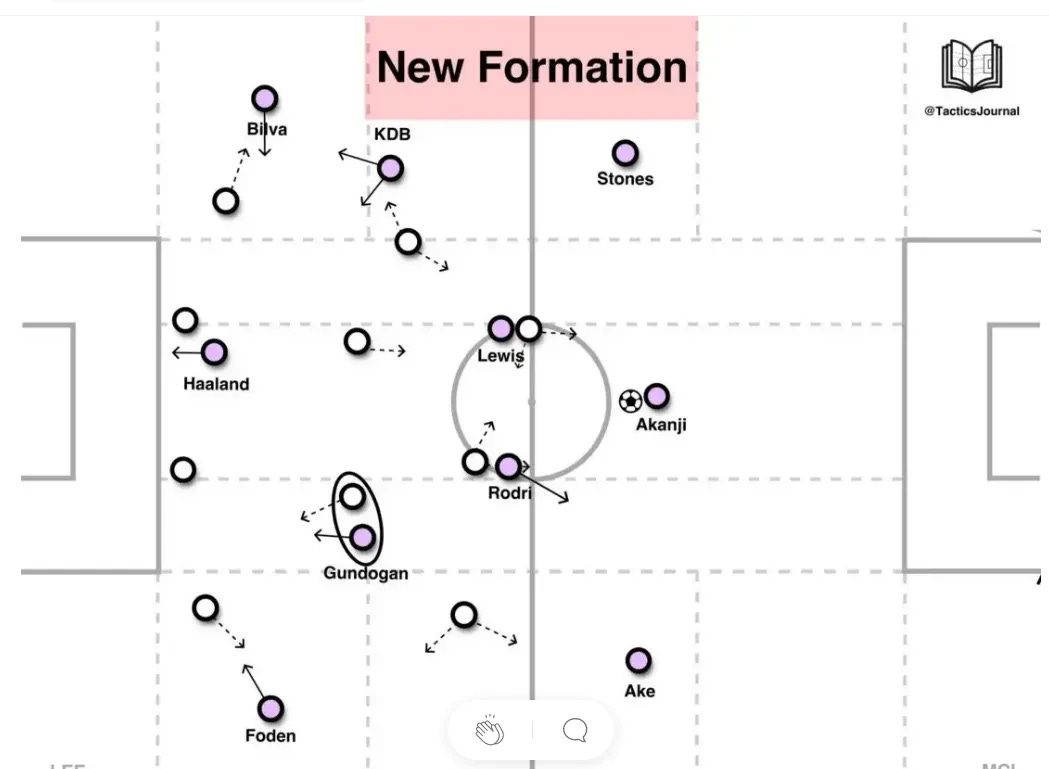



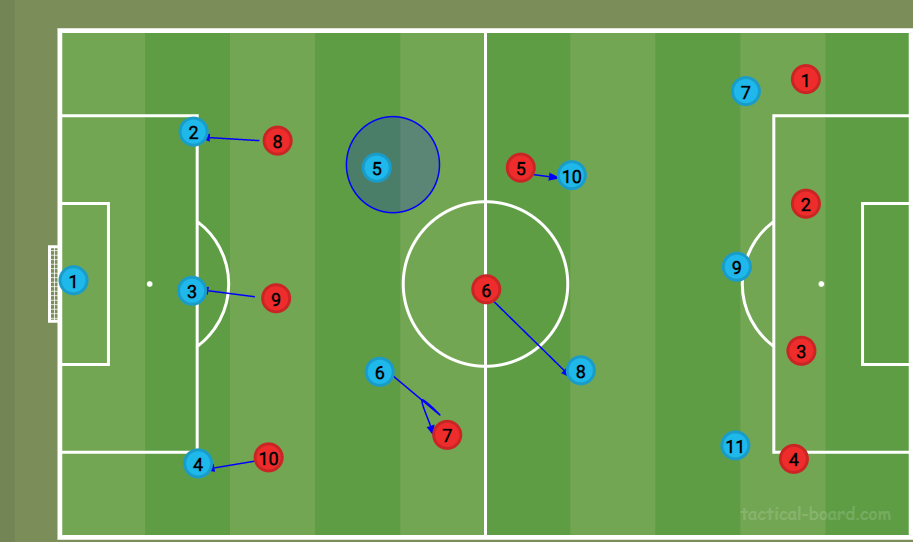

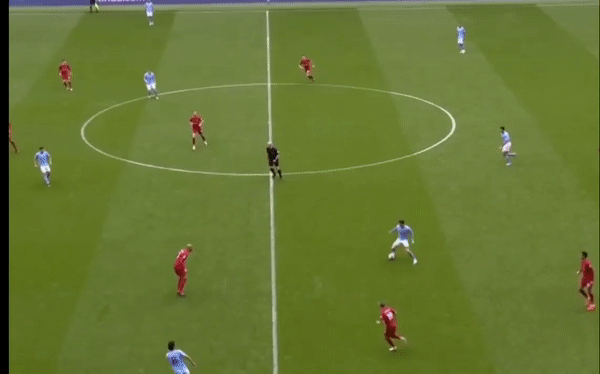



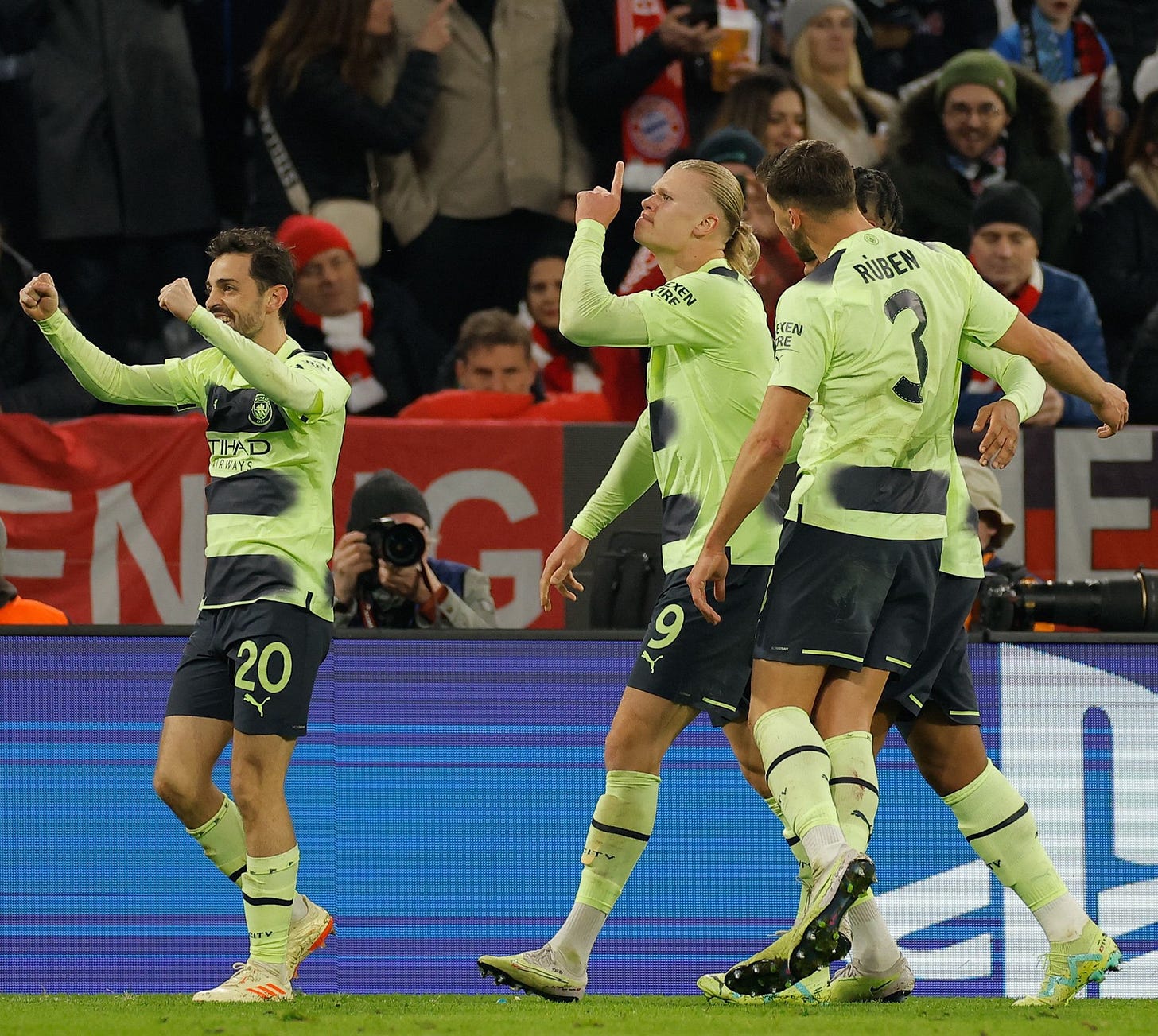
Beautiful